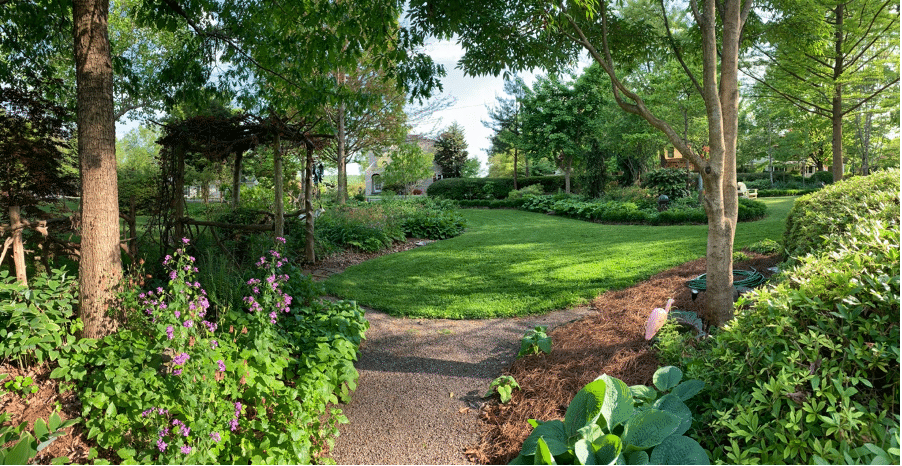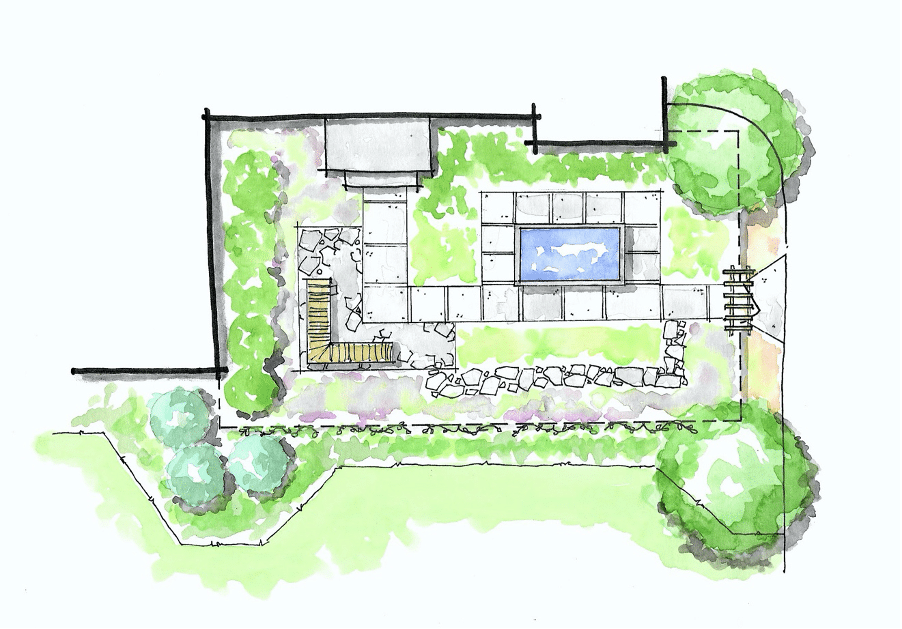Lines are everywhere. A few thoughts on how to use them in your garden.

Calm your heartbeat. We’ll be talking about different lines.
I don’t care who you are. Who doesn’t love a good line? Maybe it’s that long, snaky TSA Security line that you think ends at the Cinnabon as you have but 30 minutes to catch your flight but then discover it’s twice as long as it makes the turn around the corner. We haven’t been to Disney since our kids were tiny but I’ve heard rumors that there were still a few lines there (the deceiving kind with the ropes and many switchbacks). And ladies, I am so sorry that concerts and sporting complexes still have so much ground to make up when designing your restrooms for those venues! Alright, now that I raised your blood pressure, allow me to finally get to today’s topic (you’d be disappointed if I someday got right to the point, wouldn’t you?)
One of the key principles of garden design is the use of “lines.” They form the basis of your landscape, establishing boundaries and create a sense of movement. There are different types of lines, of course, each with its effects. This post will look at how you can incorporate lines effectively, both on your design and in your garden, for the most functional and aesthetically pleasing results possible.
Lines are essential components of garden design. They are used to create all forms and patterns within the landscape. From a functional standpoint, a line creates an edge or border between structures and materials. They also make the outlines or silhouettes of more complex shapes and forms. Designers use lines to establish various movements, shapes, and patterns in their landscape design.
Specific Uses of Lines in Garden Design
- Create Patterns – Lines can be grouped, spaced apart, placed in a perpendicular or parallel arrangement, and much more – all of which establish patterns.
- Create Forms – Lines, when drawn to create polygons and shapes, establish “forms,” which indicate the presence and positioning of features such as garden beds, pools, or patios.
- Establish Movement – Lines direct the eyes and create focal points, guiding onlookers where to look first, second, third, and so forth.
- Establish Dominance – Lines separate objects from each other, create boundaries, and give designers and clients a sense of where certain features begin and end.
- Establish Themes – Using certain types of lines creates visual themes.
A line by itself might not communicate much to an onlooker. However, the type of line speaks volumes. Different types of lines create their unique sense of movement. These lines’ presence and appearance have a physical effect on your garden’s appearance and an emotional impact on those experiencing it.

A few lines in our garden. In a nutshell, my garden design philosophy (for smaller properties such as ours) is to define a nice plot of turf grass, have good connections to different spaces, and plant the %$#!* out of everything else.
There are four main types of lines: straight lines, curved lines, vertical lines, and horizontal lines.
- Straight Lines – The most obvious of the four, straight lines create a sense of forcefulness. They’re usually formal in symmetrical designs. They function like arrows since they guide the eye directly to a focal point. They also create a direct pathway for the eyes to follow. Designers typically use straight lines to establish borders and boundaries.
- Curved Lines – If straight lines represent orderliness and formality, then curved lines are the opposite. They are informal and lend an asymmetrical feel to the garden. The sense of movement they evoke is the opposite of straight lines. Where straight lines guide the eye directly from point A to B, curved lines allow the eyes to meander, take a more scenic route, and create a tone of mystery, wondering what is around the next bend.
- Vertical Lines – Vertical lines create a more immediate sense of movement, and their main effect is to direct the eyes to look up or down. Sometimes visual continuity is broken by vertical lines and forms so be careful next time you’re tempted to just plop down a tree smack dab in the middle of your front yard as the architectural flow is often visually broken. I’ve found that pulling such features closer to the edge sometimes works best.
- Horizontal Lines – Horizontal lines create a more relaxed sense of movement. As their name suggests, they direct the eyes to move left to right. They’re typically used to establish features such as pathways, bed, and lawn shapes.

This guy is giving some serious consideration to the lines in his design.
Putting Lines Together in Your Garden Design
Now that you understand how lines function within a landscape’s design, the question is, how do you make use of them yourself? It might seem tricky if you are not a designer. However, once you’re able to identify what they look like before you put them on paper or the computer, the overall look may start to make more sense.
Start picking out features in the design you like or incorporate directly into your landscape design. For example, if you want to include a pathway you saw in your design, that would be an example of a horizontal line. Pay attention to the use of lines. Did you notice a specific pattern or theme? Do certain features seem to move in a particular direction?
Before deciding what features or amenities you want in particular in your garden, make a list. Landscape architects call this “a program”. You can say you want just a pool, a patio, a garden bed, and an area for the kids to play. Early in the design, these could be represented by simple bubbles. Once you have located each feature then comes the time to refine them with more detailed lines. Here is where many folks take the path of least resistance and just start drawing random curves as they are easy. There is nothing wrong with this approach but consider living on the edge and give some geometric shapes a go. I wrote a couple weeks ago a piece called It’s Hip to Be Square.
In this, I tried to convey the benefits of using straight lines in garden design. Everyone has their own taste and vision but doing a little stretching of the mind can create some very pleasant results.

The easy thing to do here is draw the ubiquitous curved walk to the front door. You can see that this geometric approach offers just a bit more.
So, this writing may have come across as a confusing mess. I apologize if that’s the case but at the same time I hope that now you may be slightly more aware of how lines and shapes impact the garden experience.
Till next time,
QUEUE UP FOR MORE FUN GARDEN ADVICE NEXT WEEK!
Please share and tell your friends to subscribe!
https://ahomeforyourgnome.com/

